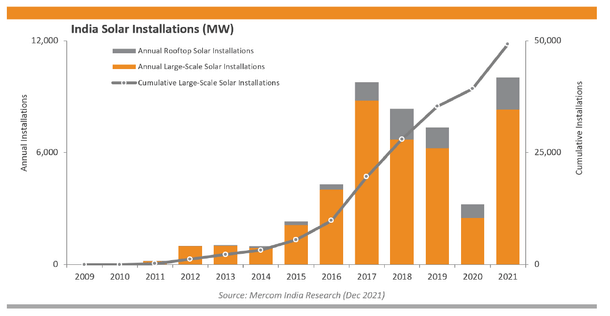News Brief
India Achieves Yet Another Landmark In Renewable Energy Sector, Adds Record 10 GW Solar Capacity In 2021
Amit Mishra
Mar 04, 2022, 03:08 PM | Updated 03:08 PM IST
Save & read from anywhere!
Bookmark stories for easy access on any device or the Swarajya app.


According to the Annual 2021 India Solar Market Update by Mercom India Research, India added a record 10 gigawatts (GW) of solar capacity in the calendar year (CY) 2021.
"India added a record 10 GW of solar in 2021, the highest ever in a year. Solar accounted for 62 per cent of new power capacity additions in 2021, the largest share of power capacity ever," the report noted.
During the year, large-scale solar projects accounted for 83 per cent of installations with 8.3 GW share, registering a 230 per cent surge year-on-year (YoY). Rooftop installations made up the remaining 17 per cent adding 1.7 GW, and registered a 138 per cent spike YoY.
What Explains The Record Capacity Addition?
A significant number of projects were moved from 2020 to 2021 due to Covid-19 extensions, which boosted the installation totals in 2021. This explains a phenomenal 210 per cent increase YoY, compared to 3.2 GW installed in CY 2020.

Total Capacity
According to the report, cumulative solar installed capacity in India was approximately 49 GW at the end of December 2021. Solar now accounts for 12.4 per cent of India’s total installed power capacity and 32 per cent of the total installed renewable capacity as of 2021.
Climate Goals
At Conference of the Parties (COP) 21, held in Paris in 2015, India had committed to increase the share of installed capacity of electric power from non-fossil-fuel sources to 40 per cent by 2030 as part of its Nationally Determined Contributions (NDCs).
To this end, the government has set a target to install 175 GW of renewable energy (RE) capacity (excluding large hydro) in the country by 2022. This includes 100 GW from solar, 60 GW from wind, 10 GW from biomass and 5 GW from small hydro power.
Current Progress
India achieved the milestone of 100 GW installed RE capacity (excluding large hydro) on 12 August 2021. According to a government press release, India stands at 4th position in the world in terms of installed RE capacity, 5th in solar and 4th in wind in terms of installed capacity.
The achievement is indeed a landmark in India’s green portfolio but is still not an encouraging sign of the country attaining its 2022 target of 175 GW installation.
Apprised of the fact that India has managed to tap a fraction of the vast potential for RE, the government enhanced its ambition to install 450 GW of renewable energy capacity by 2030.
Trailing Solar Targets
Solar energy is one of the main sources to accomplish the target of 40 per cent of electric power from non-fossil-fuel. India has set the target of achieving 40 GW rooftop solar and 60 GW ground-mounted utility scale in the country by 2022.
The country’s installed solar capacity stands at 50.31 GW as on 31 January 2022, the Central Electricity Authority (CEA) data suggests. It means we are almost certain to miss the ambitious solar targets.
The demand outlook for 2022 is strong, but significant challenges await the industry, beginning with the basic customs duty, import restrictions, and the goods and services tax on top of global supply chain issues, and high component prices, said the report.
Though the government has taken various steps to promote renewable energy including solar energy in the country, the widening gap between the stated 2022 solar targets and the current installed capacity desires a lot to be done.
Amit Mishra is Staff Writer at Swarajya.





